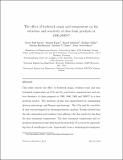| dc.contributor.author | Surup, Gerrit Ralf | |
| dc.contributor.author | Foppe, Manuel | |
| dc.contributor.author | Schubert, Daniel | |
| dc.contributor.author | Deike, Rüdiger | |
| dc.contributor.author | Heidelmann, Markus | |
| dc.contributor.author | Timko, Michael T. | |
| dc.contributor.author | Trubetskaya, Anna | |
| dc.date.accessioned | 2018-08-01T08:00:11Z | |
| dc.date.issued | 2018-07-31 | |
| dc.identifier.citation | Surup, Gerrit Ralf, Foppe, Manuel, Schubert, Daniel, Deike, Rüdiger, Heidelmann, Markus, Timko, Michael T., & Trubetskaya, Anna. (2019). The effect of feedstock origin and temperature on the structure and reactivity of char from pyrolysis at 1300–2800 °C. Fuel, 235, 306-316. doi: https://doi.org/10.1016/j.fuel.2018.07.093 | en_IE |
| dc.identifier.issn | 1873-7153 | |
| dc.identifier.uri | http://hdl.handle.net/10379/7451 | |
| dc.description.abstract | This study reports the effect of feedstock origin, residence time, and heat treatment temperature on CO2 and O2 reactivities, nanostructure and carbon chemistry of chars prepared at 1300, 1600, 2400, and 2800 °C in a slow pyrolysis reactor. The structure of char was characterized by transmission electron microscopy and Raman spectroscopy. The CO2 and O2 reactivity of char was investigated by thermogravimetric analysis. Results showed that the ash composition and residence time influence the char reactivity less than the heat treatment temperature. The heat treatment temperature and co-pyrolysis of pinewood char with biooil decreased the CO2 reactivity, approaching that of metallurgical coke. Importantly from a technological standpoint, the reactivities of char from high temperature pyrolysis (2400–2800 °C) were similar to those of metallurgical coke, emphasizing the importance of graphitizing temperatures on the char behavior. Moreover, graphitization of chars from wood and herbaceous biomass increased with the increasing heat treatment temperature, leading to formation of graphitizing carbon. | en_IE |
| dc.description.sponsorship | The authors gratefully acknowledge financial support from the Björn Wahlströms, Kempe Foundation, and Jernkontoret Stiftelsen. M.T. Timko thanks the U.S. National Science Foundation (Grant CBET-1605916). The authors acknowledge the facilities and technical support of Dr. Andras Gorzsas and Dr. Markus Broström at Umeå University. The German Federal Government, Federal State of Nordrhein-Westfalen, Deutsche Forschungsgemeinschaft (DFG) are acknowledged for their contribution toward the establishment of the Interdisciplinary Center for Analytics on the Nanoscale in the University of Duisburg-Essen. BTG Bioliquids in Netherlands is acknowledged for the pinewood biooil supply. Professor Manuel Garcia-Perez is acknowledged for the many fruitful discussions. | en_IE |
| dc.format | application/pdf | en_IE |
| dc.language.iso | en | en_IE |
| dc.publisher | Elsevier | en_IE |
| dc.relation.ispartof | Fuel | en |
| dc.rights | Attribution-NonCommercial-NoDerivs 3.0 Ireland | |
| dc.rights.uri | https://creativecommons.org/licenses/by-nc-nd/3.0/ie/ | |
| dc.subject | Biomass char | en_IE |
| dc.subject | High-temperature pyrolysis | en_IE |
| dc.subject | Reactivity | en_IE |
| dc.subject | Biooil | en_IE |
| dc.subject | Metallurgical coke | en_IE |
| dc.title | The effect of feedstock origin and temperature on the structure and reactivity of char from pyrolysis at 1300 2800 °C | en_IE |
| dc.type | Article | en_IE |
| dc.date.updated | 2018-07-31T18:14:30Z | |
| dc.identifier.doi | 10.1016/j.fuel.2018.07.093 | |
| dc.local.publishedsource | https://doi.org/10.1016/j.fuel.2018.07.093 | en_IE |
| dc.description.peer-reviewed | peer-reviewed | |
| dc.contributor.funder | National Science Foundation | en_IE |
| dc.description.embargo | 2020-07-31 | |
| dc.internal.rssid | 14718944 | |
| dc.local.contact | Anna Trubetskaya, -. - Email: anna.trubetskaya@nuigalway.ie | |
| dc.local.copyrightchecked | Yes | |
| dc.local.version | PUBLISHED | |
| nui.item.downloads | 238 | |


